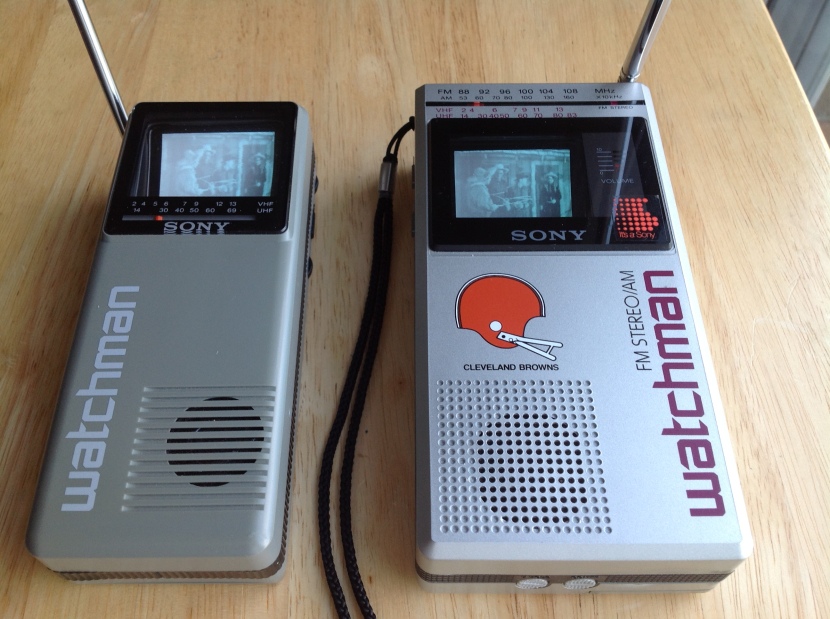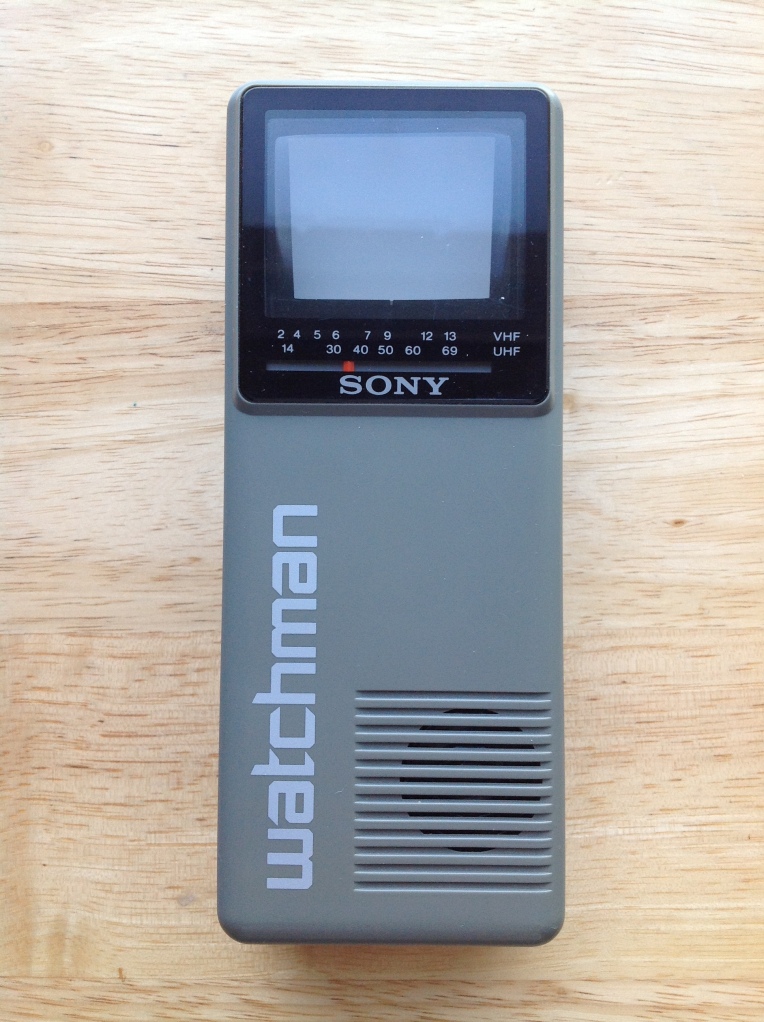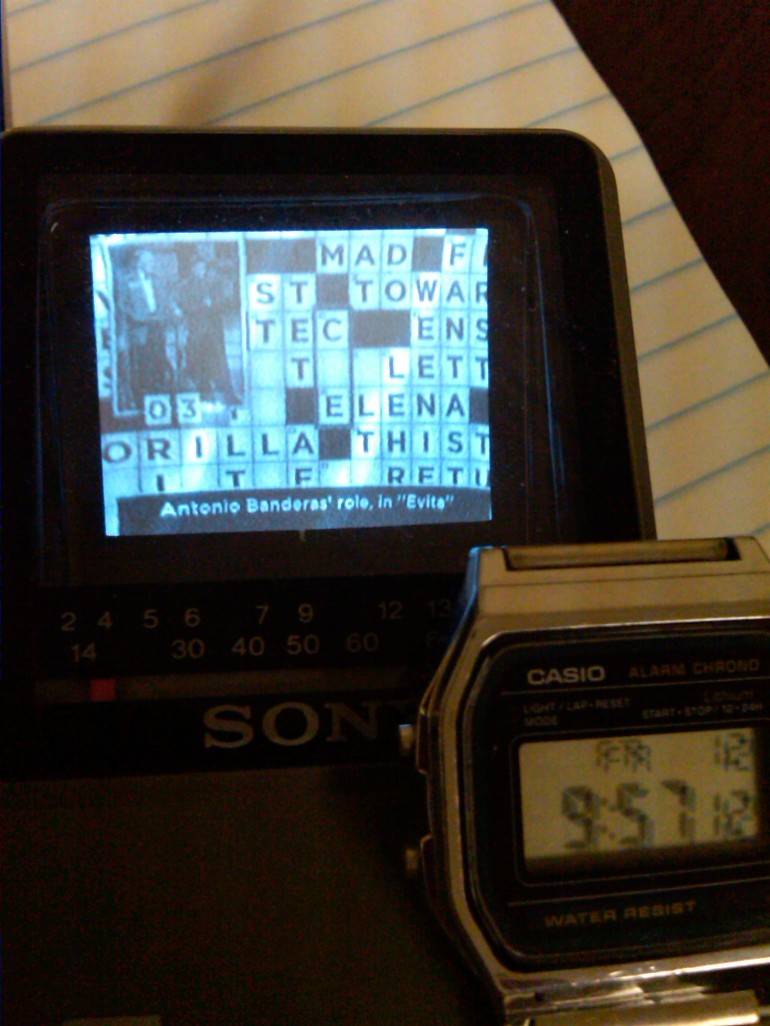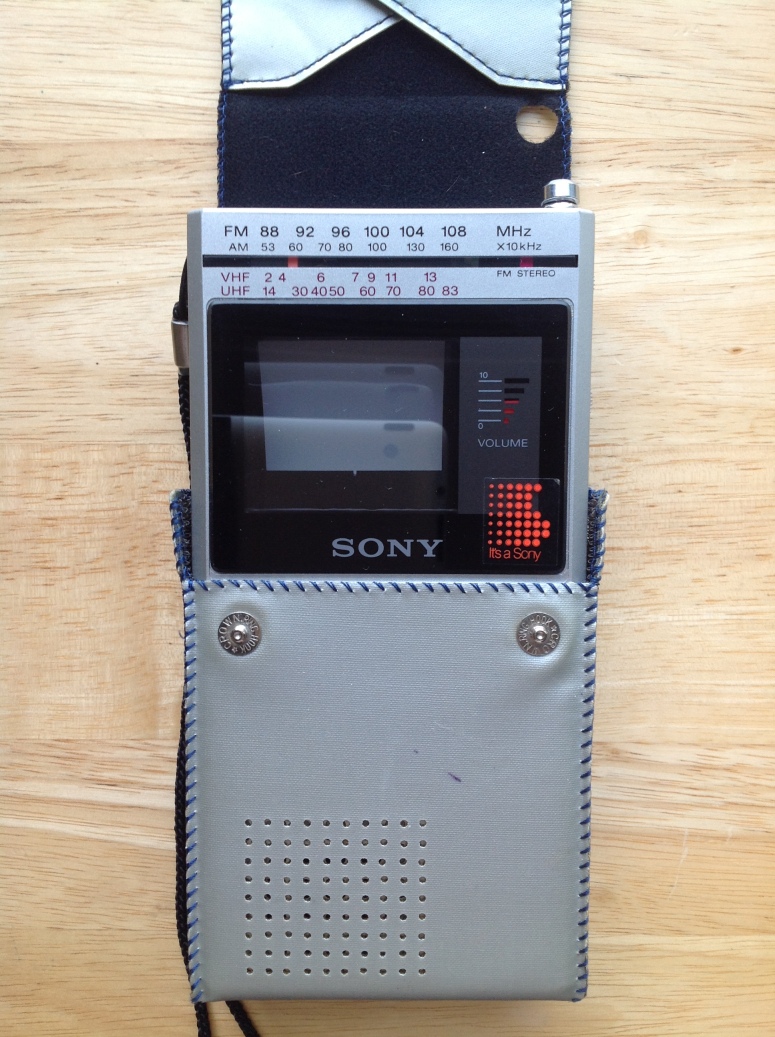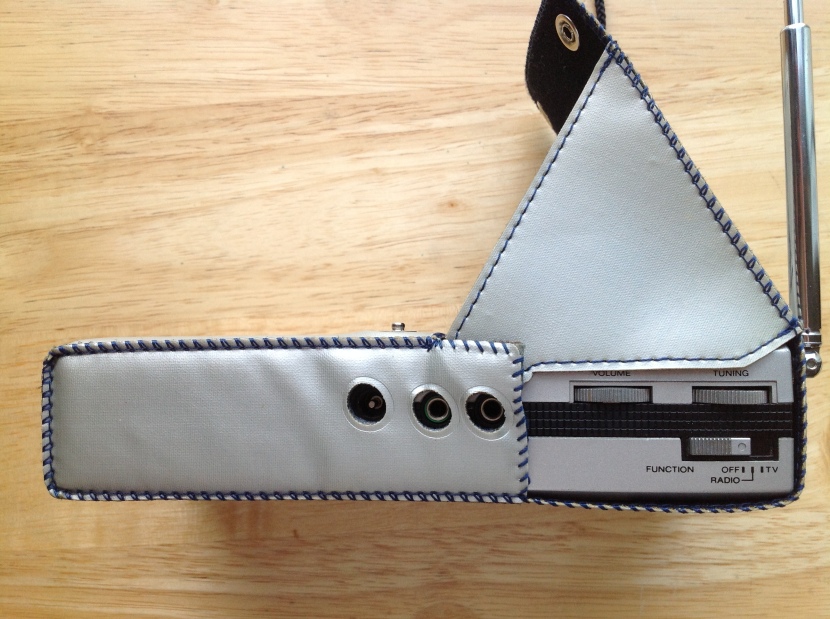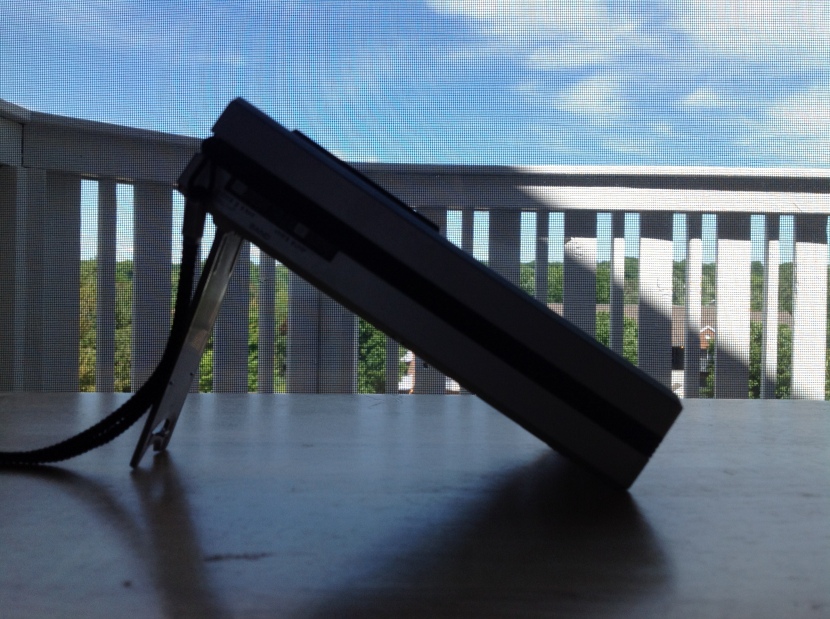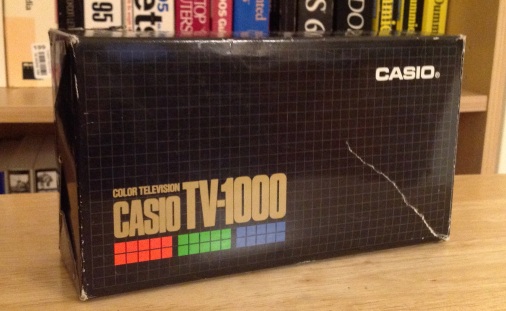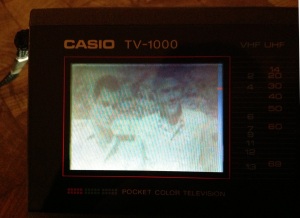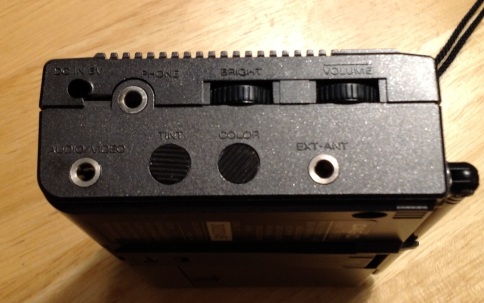Category: Handheld TVs
Sony Watchman FD-10A and Watchman FD-30A
Today we return to the extravagant world of 1980s handheld TVs.
This is my Sony Watchman FD-10A and Sony Watchman FD-30A, two of Sony’s attempts to create “Watchman” CRT handheld TVs in the 1980s.
The FD-10A, dating from 1987 is on the left and the FD-30A, dating from 1984 is on the right. They both still work, though the FD-30A seems to have a loose connection somewhere and sometimes will not turn on after you pull the antenna out. As you can see, they are both black and white sets.
My father found the FD-10A at a thrift store some years ago and I believe I found the FD-30A at Village Thrift sometime in the past two years or so.
The most distinctive thing about these TVs is what they’ve done with the CRT. On a typical CRT the electron gun is located behind the viewing surface you’re looking at. The gun is firing at a surface of phosphors that are glowing on the other side of the glass tube you’re looking into. There’s basically a straight line between your eyes, the surface of the picture tube, the glowing phosphors, and the electron gun.
Take a look at these Panasonic Travelvision handheld TVs and you can see the ergonomic issue this creates. The shape you get from putting a tiny conventional CRT into a handheld TV ends up with the screen on the short end of a long case. Holding that up to your face is very unnatural. If you’re sitting down you end up putting the TV in your lap and craning your head down to look at it. If you really wanted to hold it up to your face you would have to hold it like a telescope.
The ingenious CRT that these Watchman units use solves this problem. Their CRTs have a window built into the top of the wide end of the tube and the electron gun fires at a curved surface of phosphors located under the window.
See that? You’re actually looking down into the CRT there.
So, the electron gun ends up firing perpendicular to the viewers eyes onto the curved white area with the phosphors. While this does not do great things for the geometry of the resulting image it does mean that you can hold the Watchman in a much ore natural way as you would a portable radio or a Game Boy with your hands down near the Watchman logo and the screen facing your eyes.
This must have been difficult to design. Clearly this is from the era people remember when Sony was doing amazing things miniaturizing electronics.
The FD-10A is a fairly basic model that only has VHF/UHF and no other fancy do-dads like AM/FM or a video-in jack. As a result though it’s more lightweight and somewhat smaller than the FD-30A.
Other than an earphone jack, just about the only feature that the FD-10A has is a switch that allows you to save the batteries by only listening to TV sound.
I used the FD-10A to watch the end of analog TV on June 12, 2009. Here is an image of Cleveland’s Channel 19, WOIO-TV taken before the 10AM cutoff and moments after.
At the moment of the cutoff I took a blurry and unusable movie with my Blackberry. While some channels made a big deal about the switchover to digital on WOIO there was no fanfare other than a text explanation that scrolled very fast up the screen, followed the by the static you see in the second picture.
The FD-30A is a more full-featured set but it’s heavier and larger than the FD-10A. It has a video-in jack (using a normal stereo Y-cable), AM/FM radio (with FM stereo), a DC power input, and a kickstand.
This FD-30A also came with a cloth case. All of the controls are accessible through the sides of the case so when the case is closed you can easily use the FD-30A as a rather weighty AM/FM radio.
The real party piece of the case though is that the cover can become a hood by unfolding flaps that attach to Velcro on either side of the Sony logo.
I supposed this might help in bright Sun conditions, but I couldn’t see using this thing in the rain at all.
One thing I like to think about when I collect items like this is what would people at the time thought about them? That is to say, if you walked into an electronics store in the 1980s and wished to purchase a handheld TV with your hard-earned money, which one should you have bought?
As a collector, I love the styling on the Casios such as the TV-400 and the TV-1000 here. These Sony Watchman units do not have the same 80s flair that the Casio do. I’m sure salespeople hawking the Casios would have been buzzing about the stunning newness of LCD technology and the significant advance of on-screen electronic tuning.
In reality, those Casios are awful. Even if you look past the inherent awfulness of first generation passive-matrix LCDs screens the electronic tuning is disturbingly bad. Anyone who has ever tuned in analog TV knows that you always have to fiddle with the tuning. There’s no way to do that with the Casios. If they don’t find your desired channel, they just tune right on by.
So, what you really want is a TV with analog tuning. I think you also want a CRT. I still need to see what a quality 80s active-matrix LCD looks like but even so I don’t think the LCD technology of the time could hold a candle to the contrast and crispness of a CRT. Even if those CRT handheld TVs ate batteries like vampires, I think the picture quality would still be worth it.
Personally, I would have bought a FD-10A. It’s simple to operate and it’s more convenient than the larger and heavier FD-30A.
But then again, if this was the 80s and you were blowing a wad of cash on something as decadent as a handheld TV, you probably want the FD-30A with all of it’s bells and whistles.
Casio TV-1000
We’ve all become accustomed to “the smartphone stare”. You know, when someone is hunched over their smartphone, oblivious to the world around them, bathed in the glow of their smartphone’s screen. I admit, I can be found in this state several times on the average day.
The magic of the “smartphone stare” is the magic of the personal electronics revolution: It’s the way that an electronic device can be made small enough that you can use it without sitting down. You don’t need a room in your house for it and you don’t need any special furniture. You just pull it out of your pocket and commune with a piece of electronics. When a piece of electronics can come with you anywhere you go and can be used at practically any time it becomes something more intimate.
The “smartphone stare” might seem like a recent phenomenon, but videogame enthusiasts will recall that for them it basically started in 1989 with the Game Boy and Tetris, which for many people was the first really killer portable gaming experience.
But, even before the Game Boy a handful of early adopters could be found basked in the glow of their handheld TVs.
I have a particular affection for the various attempts to make a usable handheld TV in the 1980s. For one, I love the 80s styling. They’re like little jewel boxes of 80s chic. For another, these devices are relatively easy to find and even easier to store. Also, these devices were pushing the boundaries of what was possible technologically, and I respect that. Finally, I’m fascinated by how at the time these were esoteric luxury devices and today they are basically semiconductor trash.
Of the vintage handheld TVs I own the Casio TV-1000 is my favorite. This was one of Casio’s first attempts to make a color LCD handheld TV.
I found it at the Village Discount on State Road in Cuyahoga Falls with its original box, instructions, and warranty card.
While it does have a backlight it also has an interesting feature where you can open up this door in the back to allow light in, as a way to conserve battery power.
The part that folds down there is actually the battery compartment, which is smart because it gives that section some heft to weight the set while it’s folded down. The interesting thing is that with that part open you can see the innards of the backlight diffuser, which is located at the bottom of that angled transparent section, and how it’s meant to distribute light across the screen evenly.
Image quality, as one would expect from a mid-1980s passive LCD is atrocious. My understanding is that the TV-1000 was an attempt to produce a more affordable color micro TV than it’s contemporaries the Epson ET-10 and the Seiko T-102 and as a result it uses a passive LCD rather than an active LCD. I can’t say I’ve ever seen a passive LCD screen that was ever any good.
Here I am trying to tune in one of the last low-power analog TV stations in the area, WAOH-LP (oddly enough, they were showing a black and white program).
Notice the onscreen blue bar on the side with the red hash mark on the right side of the display. In order to tune the TV-1000 you would select VHF or UHF and then press the up or down channel button once so that it would start scanning for a channel. The red mark shows what channel it’s currently tuned to. The scanning process makes it difficult to tune in a marginal station because often it will scan right past. I would vastly prefer a manual tuning knob like the CRT Sony Watchman sets from the same era. But I suppose at the time this type of tuning seemed more high tech.
The TV-1000 also has a standard RCA 1/8th inch AV input, which is useful in the post analog TV doomsday. Use red/right for video and white/left for audio.
Here is Super Mario World on my Yobo FC Twin (which I shall discuss in the future). As you can see, the TV-1000’s color reproduction is awful, but that’s the reality of mid-80s passive LCDs. The sound however, is loud and crisp.
Right now the TV-1000 is the only 1980s-vintage LCD handheld TV I own, but I’m always on the lookout for others. I do, however, have several micro CRT handheld TVs from the 1980s: A functional Sony Watchman FD-10A, a functional Sony Watchman FD-30A, and a non-functional Panasonic TR-1010P.

